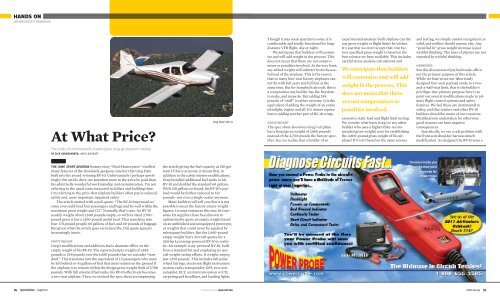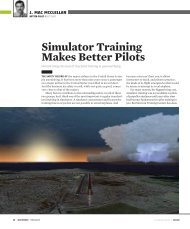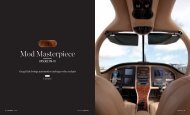August issue of Sport Aviation by Van's founder Dick ... - Left Seat
August issue of Sport Aviation by Van's founder Dick ... - Left Seat
August issue of Sport Aviation by Van's founder Dick ... - Left Seat
Create successful ePaper yourself
Turn your PDF publications into a flip-book with our unique Google optimized e-Paper software.
HANDS ON<br />
HOMEBUILDER’S HANDBOOK<br />
At What Price<br />
Greg Hale’s RV-10<br />
Though it may seem spartan to some, it is<br />
comfortable and totally functional for longdistance<br />
VFR flight, day or night.<br />
We anticipate that builders will customize<br />
and will add weight in the process. This<br />
does not mean that there are not compromises<br />
or penalties involved. At the very least,<br />
any added weight will subtract from the useful<br />
load <strong>of</strong> the airplane. This is the reason<br />
that so many four-seat factory airplanes cannot<br />
fly with full seats and full fuel at the<br />
same time. But for homebuilt aircraft, this is<br />
a compromise any builder has the freedom<br />
to make, and many do. But adding 248<br />
pounds <strong>of</strong> “stuff” is rather extreme. It is the<br />
equivalent <strong>of</strong> adding the weight <strong>of</strong> an entire<br />
ultralight, engine and all. It’s almost equivalent<br />
to adding another pair <strong>of</strong> RV-10 wings.<br />
Gross Weight<br />
The spec sheet also notes Greg’s airplane<br />
has a listed gross weight <strong>of</strong> 2,800 pounds<br />
instead <strong>of</strong> the 2,700 pounds the factory specifies.<br />
Yes, we realize that a builder <strong>of</strong> an<br />
experimental amateur-built airplane can list<br />
any gross weight or flight limits he wishes.<br />
It’s just that we don’t accept that. Our factory<br />
specified gross weight is based on the<br />
best science we have available. This includes<br />
careful stress analysis calculations and<br />
We anticipate that builders<br />
will customize and will add<br />
weight in the process. This<br />
does not mean that there<br />
are not compromises or<br />
penalties involved.<br />
extensive static load and flight limit testing.<br />
We wonder what basis Greg (or any other<br />
builder who uses a higher-than-recommended<br />
gross weight) uses for establishing<br />
the 2,800-pound gross weight <strong>of</strong> his airplane<br />
If it isn’t based on the same science<br />
and testing, we simply cannot recognize it as<br />
valid, and neither should anyone else. Any<br />
“penciled in” gross weight increase is just<br />
wishful thinking. The laws <strong>of</strong> physics are not<br />
repealed <strong>by</strong> wishful thinking.<br />
Harnesses<br />
But this discussion <strong>of</strong> payload trade-<strong>of</strong>fs is<br />
not the primary purpose <strong>of</strong> this article.<br />
While we hate to see our laboriously<br />
designed four-seat payload erode to a twoand-a-half-seat<br />
limit, that is the builder’s<br />
privilege. Our primary purpose here is to<br />
point out several modifications made to primary<br />
flight control systems and safety<br />
features. We feel these are detrimental to<br />
safety, and that readers and other RV-10<br />
builders should be aware <strong>of</strong> our concerns.<br />
Modifications undertaken for otherwise<br />
good reasons can have negative<br />
consequences.<br />
Specifically, we see a real problem with<br />
the front seat shoulder harness attach<br />
modification. As designed the RV-10 uses a<br />
The costs <strong>of</strong> a homebuilt masterpiece may go beyond money<br />
By <strong>Dick</strong> VanGrunsven, Van’s Aircraft<br />
The June <strong>Sport</strong> <strong>Aviation</strong> feature story “Mod Masterpiece” extolled<br />
many features <strong>of</strong> the absolutely gorgeous interior that Greg Hale<br />
built into his award-winning RV-10. Unfortunately (perhaps unwittingly)<br />
the article drew our attention more to the price he paid than<br />
his admittedly wonderful workmanship and customization. I’m not<br />
referring to the usual costs measured in dollars and building time;<br />
I’m referring to the price that airplane builders <strong>of</strong>ten pay in reduced<br />
utility and, more important, impaired safety<br />
The article started with a pull-quote: “The RV-10 impressed us<br />
since you could load four passengers and bags and be well within the<br />
maximum gross weight and CG.” Normally, that’s true. An RV-10<br />
usually weighs about 1,600 pounds empty, so with its rated 2,700-<br />
pound gross it has a 1,100-pound useful load. That translates into<br />
four 170-pound people, 60 gallons <strong>of</strong> fuel, and 60 pounds <strong>of</strong> baggage.<br />
But given what the article goes on to describe, this quote appears<br />
increasingly ironic.<br />
Empty Weight<br />
Greg’s modifications and additions had a dramatic effect on the<br />
empty weight <strong>of</strong> his RV-10. The reported empty weight <strong>of</strong> 1,848<br />
pounds is 248 pounds over the 1,600 pounds that we consider “standard.”<br />
This translates into the equivalent <strong>of</strong> 1.5 passengers who must<br />
be left behind or 41 gallons <strong>of</strong> fuel that must remain on the ground if<br />
the airplane is to remain within the design gross weight limit <strong>of</strong> 2,700<br />
pounds. With full standard fuel tanks, his RV-10 effectively becomes<br />
a two-seat airplane. Then, we noticed the spec sheet accompanying<br />
the article giving the fuel capacity as 120 gallons!<br />
If this is accurate, it means that, in<br />
addition to the cabin interior modifications,<br />
Greg installed additional fuel tanks in his<br />
RV-10 and doubled the standard 60 gallons.<br />
With 120 gallons on board, his RV-10’s payload<br />
would be further reduced to 132<br />
pounds—not even a single-seater anymore.<br />
Many builders will tell you that it is not<br />
possible to meet the factory empty weight<br />
figures. In some instances this may be true—<br />
some kit suppliers have been known to<br />
optimistically quote an empty weight based<br />
on an unfinished and unequipped prototype,<br />
or weights that could never be equaled <strong>by</strong><br />
subsequent builders. But the 1,600-pound<br />
empty weight Van’s Aircraft quotes for a<br />
260-hp Lycoming-powered RV-10 is realistic.<br />
An example is my personal RV-10, built<br />
from a standard kit and employing no special<br />
weight-saving efforts. It weighs, empty,<br />
just 1,595 pounds. This includes full paint,<br />
wheel fairings, electronic flight instrument<br />
system, radio, transponder, GPS, two-axis<br />
autopilot, ELT, an intercom system w/CD,<br />
carpeting and headliner, and landing lights.<br />
94 <strong>Sport</strong> <strong>Aviation</strong> <strong>August</strong> 2011 PHOTOGRAPHY <strong>by</strong> John Dettor<br />
www.eaa.org 95
HANDS ON<br />
HOMEBUILDER’S HANDBOOK<br />
Harness Anchoring Option 1<br />
Mount shoulder<br />
harness above a<br />
line extending<br />
down 40 degrees<br />
from the shoulder.<br />
Install headrest to<br />
reduce neck injuries.<br />
Pad or cover hard<br />
or sharp objects to<br />
prevent leg injuries.<br />
Considerable conversation on this<br />
article and subject has taken place on<br />
Facebook and Oshkosh365 since Van’s<br />
Aircraft posted this article on its Facebook<br />
page in late June. Since then Greg Hale has<br />
posted a response on his Web page. To read<br />
Greg’s clarification and the responses on<br />
Facebook and Oshkosh365, visit<br />
www.<strong>Sport</strong><strong>Aviation</strong>.org.<br />
40˚<br />
Harness Anchoring Option 2 (not recommended)<br />
Install headrest to<br />
reduce neck injuries.<br />
<strong>Seat</strong> belt should bisect angle<br />
between seat back and pan.<br />
<strong>Seat</strong> belt should bisect angle<br />
between seat back and pan.<br />
Pad or cover hard<br />
or sharp objects to<br />
prevent leg injuries.<br />
two-strap shoulder harness attached to a<br />
hard point in the structural cabin top.<br />
We used the two-strap (one over each<br />
shoulder) harness because it is the<br />
universal aircraft standard and has been<br />
demonstrated to be superior to the<br />
automotive-style single cross-strap.<br />
Anchoring the harness to a hard point in<br />
the cabin top provides a near ideal load<br />
path for crash restraint forces. (See<br />
Illustration 1.)<br />
The subject airplane uses a single<br />
cross shoulder harness anchored to a<br />
hard point in the fuselage under and aft<br />
<strong>of</strong> the seat. The strength <strong>of</strong> the anchor<br />
point is somewhat irrelevant in this<br />
installation, because the load path<br />
essentially applies the crash loads to the<br />
top <strong>of</strong> the seat back. (See Illustration 2.)<br />
The low anchor point for the shoulder<br />
harness causes the tension in the strap to<br />
bear down on the occupant’s spine, and to<br />
pull forward on the top <strong>of</strong> the seat back.<br />
The back <strong>of</strong> the Oregon Aero seat<br />
supplied in the RV-10 kit was not<br />
designed to withstand shoulder harness<br />
crash impact acceleration forces. When<br />
the seat back fails, the upper body will<br />
pitch forward because the shoulder<br />
harness essentially becomes slack. While<br />
some automotive seats do apply the<br />
shoulder harness loads to the top <strong>of</strong> the<br />
seat backs, we assume that those heavy<br />
automotive seats have been adequately<br />
designed and tested for this purpose. The<br />
RV-10 seats have been designed and<br />
tested <strong>by</strong> Oregon Aero Inc. to withstand<br />
anticipated crash impact loads <strong>of</strong> the<br />
occupant, but not acceleration loads<br />
transmitted through shoulder harnesses.<br />
96 <strong>Sport</strong> <strong>Aviation</strong> <strong>August</strong> 2011 illustration courtesy <strong>of</strong> Van’s Aircraft<br />
www.eaa.org 97
HANDS ON<br />
HOMEBUILDER’S HANDBOOK<br />
Another safety feature <strong>of</strong> the Oregon<br />
Aero seats is the foam used to make the<br />
cushions. Its type, density, and lamination<br />
schedule have been carefully tailored and<br />
tested to absorb vertical impact loads. Any<br />
changes or replacements may not provide<br />
equivalent protection.<br />
In addition, the modification made to<br />
the active seat belt attach points is suspect.<br />
Our design provides for each belt to be<br />
attached directly to anchor points in the<br />
airframe structure. Anticipated crash<br />
acceleration loads are transferred in<br />
linear tension into these hard points.<br />
In the subject airplane, the seat belts are<br />
attached to a small diameter cross shaft<br />
between the intended structural hard<br />
points. Crash acceleration loads will be<br />
applied to this cross shaft, loading it in<br />
bending, which in turn will apply eccentric<br />
(twisting) loads to the mounting brackets<br />
in the cabin structure.<br />
The rear seat shoulder harness modification<br />
<strong>of</strong> the subject airplane also uses a<br />
single cross-strap rather than the standard<br />
RV-10 dual-strap harness. The load path<br />
into the airframe is again an unknown—in<br />
contrast to the static load testing performed<br />
on the factory-supplied harness<br />
assemblies. These transmit loads linearly<br />
to the aft fuselage structure.<br />
Rudder Cables<br />
Another worrying modification altered<br />
the attachment <strong>of</strong> the rudder cables to the<br />
rudder pedals. Greg used an <strong>of</strong>fset stud on<br />
the rudder pedal to which the rudder<br />
cable is attached. While this may provide<br />
a more attractive cabin appearance, it<br />
causes an inferior load path for the rudder<br />
control forces. Cable tension loads will<br />
apply a twisting force to the rudder pedal<br />
attach horn.<br />
Extra Fuel Tanks<br />
While we’re on the subject <strong>of</strong> modifications<br />
and how they might affect safety, let’s go<br />
back to that question <strong>of</strong> 60 extra gallons <strong>of</strong><br />
fuel. When the fuel load causes an over<br />
gross weight condition, it adversely affects<br />
performance and flight safety. Even if the<br />
additional fuel weight is within gross weight<br />
and CG limits, the location <strong>of</strong> the added<br />
weight can adversely affect the aircraft’s<br />
polar moment <strong>of</strong> inertia. Reduced to its<br />
most understandable form, it means that the<br />
spin recovery characteristics <strong>of</strong> the aircraft<br />
will be affected. While the article never says<br />
where the extra fuel goes in this RV-10, the<br />
most likely place for additional fuel tanks<br />
would be in the outer sections <strong>of</strong> the wing—<br />
outboard <strong>of</strong> the standard wing root leading<br />
edge tanks. With regard to the polar<br />
Who Owns the Margin<br />
It seems common practice among homebuilders to second-guess the factory engineers, particularly<br />
regarding gross weight increases. Because <strong>of</strong> all <strong>of</strong> the added features, empty weight creep erodes the<br />
aircraft’s useful load. The simple solution for the homebuilder is to “pencil in” a new gross weight<br />
limit. “It’s only 100 pounds (3.7 percent) more; how much effect can that possibly have” Imagine this<br />
example: You are on a mid-size airliner with a gross weight <strong>of</strong> 270,000 pounds. Just before leaving<br />
the gate, the captain comes on the PA system and says: “We’ve overbooked more than usual today,<br />
so we’re going to assume that the factory engineers over-designed this airplane and allowed an<br />
abundant safety margin. We’re going to take <strong>of</strong>f at 280,000 pounds instead. So move over, there are<br />
50 more passengers coming on board.” Run the numbers; it’s the same over-weight ratio as simply<br />
pencilling in an additional 100 pounds to the gross weight <strong>of</strong> an RV-10.<br />
Along with gross weight increases, some builders take the same liberties with horsepower increases<br />
and speed increases, betting their lives on the assumption that the airplane is designed with a huge<br />
margin <strong>of</strong> safety—it is really far stronger than it needs to be. This is not really true. Certificated aircraft,<br />
and well-designed kit aircraft, are designed to withstand limit loads at specified maximum weights.<br />
During testing, they are subjected to ultimate loads, which are higher than design limit loads <strong>by</strong> a<br />
specified margin. Yes, there is a margin between the design and ultimate strengths. But that margin<br />
belongs to the engineer. He owns the margin. It is his insurance against the things he doesn’t know or<br />
can’t plan for, and the pilot’s insurance against human error, material variations, and the ravages <strong>of</strong><br />
time. Wise pilots respect this design safety philosophy and leave this insurance policy in effect <strong>by</strong><br />
operating strictly within established limits.<br />
moment <strong>of</strong> inertia, this is possibly the<br />
worst place (other than in the tail) to add<br />
weight to an airplane. Also, weight added<br />
anywhere in the wing will affect the flutter<br />
characteristics <strong>of</strong> the wing. The RV-10<br />
wing has been subjected to ground vibration<br />
testing with standard tanks both full<br />
and empty. With significant weight <strong>of</strong> any<br />
kind, structural or otherwise, added to the<br />
wing, the flutter speed limits will change—<br />
and until the new arrangement is tested,<br />
nobody knows what the new limits will be.<br />
Responsibility<br />
Like many kit-plane suppliers, we<br />
endeavor to supply complete, thoroughly<br />
designed and tested airframe kits. It is our<br />
hope that builders will construct the airframe<br />
assemblies in compliance with our<br />
proven design. Most do. Details such as<br />
instrumentation, avionics, and cabin interior<br />
appointments are <strong>of</strong>ten not included<br />
in kits because we know from experience<br />
that builders have very special individual<br />
preferences for these details. These are<br />
areas where builders can usually express<br />
their individuality without as much concern<br />
for safety <strong>of</strong> flight as would be the<br />
case with changes to the structure or<br />
aerodynamics. I say usually because even<br />
any seemingly insignificant part <strong>of</strong> an aircraft<br />
can affect safety <strong>of</strong> flight. With<br />
reasonable care, interior appointments<br />
will remain benign.<br />
We all know that builders <strong>of</strong> experimental<br />
amateur-built aircraft have the<br />
right to make changes to their aircraft at<br />
will—whether or not their changes are<br />
based on good science. If they choose to<br />
operate the aircraft with a lesser or<br />
unknown margin <strong>of</strong> safety, that is their<br />
prerogative. However, unless the aircraft<br />
is single-seat, any passengers carried in<br />
that aircraft will be exposed to the same<br />
unknowns that the pilot has accepted for<br />
himself. We feel that this is a responsibility<br />
<strong>of</strong>ten overlooked <strong>by</strong> pilots. While they<br />
may be willing to accept certain risks for<br />
themselves, what should their responsibility<br />
be to their spouses, friends,<br />
children, and grandchildren<br />
<strong>Dick</strong> VanGrunsven, EAA 3204, is the<br />
designer, <strong>founder</strong>, and CEO <strong>of</strong> Van’s Aircraft in<br />
Aurora, Oregon.<br />
98 <strong>Sport</strong> <strong>Aviation</strong> <strong>August</strong> 2011 www.eaa.org 99




